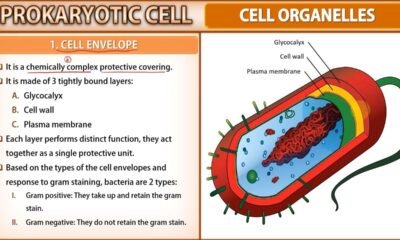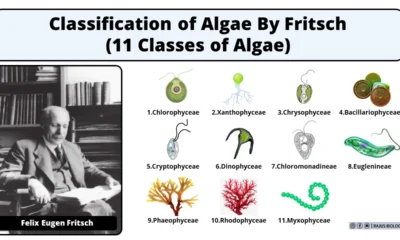Blog
Phylum Porifera: General Characteristics and Classification | 100% Free Biology Notes

In this article we will discuss about Phylum Porifera: General Characteristics and Classification | Phylum Porifera: General Characteristics and Classification
Habit & Habitat
- Aquatic (mostly marine and few fresh water)
- Sedentary (not migratory)
- Solitary or colonial
Porifera General characteristics
- They are pore bearing animals
- Surface of the animal bears minute pores called ostia
- These pores lead into a central hollow cavity, these internal cavity is called spongocoel
- It opens to outside through a large circular opening called osculum
- Water is drawn into it through a series of pores into a central cavity and then flows out of the
- Sponge through a large opening at the top called osculum
Porifera Body Wall
The thin body wall which encloses the spongocoel, consists of
I) Pinacoderm (Outer Layer) – Thin and flat cells of pinacoderm is called pinacocytes. It protects the internal structure of body
II) Mesenchyme (Middle Layer) – It consists of a gelatinous matrix of protein called mesogloea, Amoeba like cells and skeletal elements. Amebocytes pick up food from choanocytes and take food to other cells. Skeleton make up of network of protein fibres and spicules. Network of protein fibres called spongin. Spicules made up of Caco3 (Calcareous spicules) or Silica (Siliceous spicules)
III) Choanoderm (Inner Layer) – Spongocoel are lined with choanocytes. Flagella that spins to pull in water and food. Collar of choanocytes traps plankton form water.
Water Circulatory System
- The water circulatory system of sponges also called as canal system
- It is unique feature of sponges
- Water enters through ostia in the body wall into spongocoel and goes out though osculum
- This pathway of water transport is helpful in food gathering, respiration exchange and removal of wastes
Reproduction
Reproduction takes place by asexual or sexual methods
a) Asexual Reproduction – Exogenous or endogenous budding. Endogenous buds of asexual reproduction in sponge are known as Gemmules
b) Sexual Reproduction – Sponges are hermaphrodite, Fertilization internal and cross due to protogynous condition. Development is indirect (Larval stage is present).
Classification of Sponges
Class 1. Calcarea
- They have a skeleton of separate calcareous spicules
- Body shape vase-like or cylindrical
- Occur in shallow waters in sea
- E.g. Sycon & Grantia
Class 2. Hexactinellida
- They have a skeleton of siliceous spicules
- They have cylindrical or funnel-shaped body
- Found in deep tropical seas
- E.g. Euplectella & Farnera
Class 3. Demospongiae
- They have a skeleton of spongin fibres
- Body shape is irregular
- Generally marine, few freshwater forms
- E.g. Oscarella & Spongilla

 Blog7 months ago
Blog7 months ago[PPT] Human Reproduction Class 12 Notes
- Blog7 months ago
Contribution of Indian Phycologists (4 Famous Algologist)
- Blog7 months ago
PG TRB Botany Study Material PDF Free Download

 Blog7 months ago
Blog7 months agoCell The Unit of Life Complete Notes | Class 11 & NEET Free Notes

 Blog7 months ago
Blog7 months ago[PPT] The living world Class 11 Notes

 Blog7 months ago
Blog7 months agoClassification of Algae By Fritsch (11 Classes of Algae)

 Blog7 months ago
Blog7 months agoJulus General Characteristics | Free Biology Notes
- Blog7 months ago
Class 12 Biology Notes Chapter wise PPT












